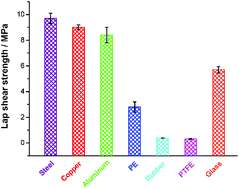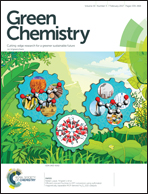5-Hydroxymethyl-2-vinylfuran: a biomass-based solvent-free adhesive†
Abstract
5-Hydroxymethylfurfural (HMF) is an important platform chemical derived from biomass. Tremendous efforts have been made to transform HMF into valuable chemicals for applications in biofuels, materials science, and pharmaceuticals. Here we report the conversion of HMF into 5-hydroxymethyl-2-vinylfuran (HMVF), a versatile adhesive. HMVF can bond to a variety of substrates, e.g. metal, glass, plastics and rubber, under heating or acid treatment at room temperature. Mechanistic studies show that the vinyl group undergoes free radical polymerization and the hydroxyl group dehydrates to form an ether linkage to crosslink HMVF under either heating or acid treatment. The bonding strength (τ) of HMVF cured by heating (h-HMVF) is close to that of Krazy Glue (Loctite 401, cyanoacrylate) and higher than that of white glue (Pattex No. 710, PVA) and Pattex PKME15C epoxy glue. The outstanding adhesive performance of HMVF is attributed both to the interaction of hydroxyl groups with substrates and crosslinking by etherification between hydroxyl groups. Similar to Krazy Glue, HMVF is also used in its monomer form, which eliminates the use of solvents. Cells show good adhesion on crosslinked HMVF, which makes HMVF a potential bio-adhesive.


 Please wait while we load your content...
Please wait while we load your content...